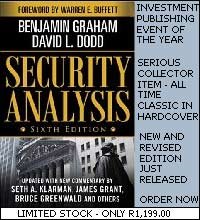
Going from left to right on the headings at the top:
- Rank, JSE Ticker code, Share name, industry, price at trough
- P1 to P9 are Piotroski sub-scores
- TOT = Piotroski overall "F" score (Financial robustness)
- MCAP = market capitalisation at trough price
- Trade/day = Average trades per day for last 30 days (liquidity)
- PE = Price-to-Earnings ratio in trough
- P2Bk = Price-to-Book Ratio in trough
- DE = Debt-to-Equity Ratio
- DY = Dividend Yield
- GR = positive & growing earnings per share in last financials
The PowerStocks ValuScore is then displayed:
- "F" score for Piotroski (inclusive of bonus point)
- "P/E" score for PE ratio
- "P2B" score for price:book value (inclusive of bonus point)
- TOT is total ValuScore
Shares are then grouped into ValueFinders, PriceFinders(a) and (b), Piotroski Universe etc. These are the PowerStocks Screens whose performance was discussed HERE.
You may elect to exclude small-cap and/or illiquid stocks from your portfolio (these are the grey-shaded shares but bear in mind we have shown that these contribute quite a bit to overall growth over 5 years).
You may also elect to use the DE, GR and EY fields to further apply selection criteria. Buffet, apart from using the techniques we have described on this blogsite, also avoided highly indebted stocks (DE>40%) in a downturn and focussed on high dividend yielding (DY) stocks that were showing EPS growth (GR). Note that our research has shown that eliminating these stocks significantly downgraded the performance of the portfolios (ie they had no negative bearing on ultimate growth achieved by portfolio inclusion).
It is recommended that you focus your attentions on the PowerStocks GrowthFinders, which are shares with ValueScores of 5 and 6 as these have shown to be the top performing portfolios. However, should you eliminate stocks that are small-cap or illiquid, or have debt:equity rations above 40% or have low dividend yields you will land up with a much smaller portfolio which may not be a good idea as ideal portfolio size should be at least 10 stocks. It is then suggested you consider stocks with ValuScores of 4 as well (essentially a PriceFinder(b) portfolio) as these have shown to perform nicely in the first 3 years of the recovery.
From the table you can see that if you focus only on larger cap, liquid issues we only have 7 shares in ValueFinder and 8 shares in GrowthFinder(b). We think you are better off either including all the small-cap/illiquid stocks (making 18 stocks in total) or including shares with ValueScore of 4 (making 13 stocks in total) to get to a better sized diversified portfolio.
NEXT UP : HOW TO SIZE YOUR PORTFOLIO ALLOCATIONS












